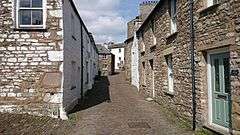Thomas de Dent
Thomas de Dent (died after 1361) was an English born cleric and judge who held high office in Ireland, and was praised as a diligent and hard working Crown official. [1]

He was born at Dent, Cumbria.[2] He took holy orders, and became a clerk in Royal service. He is first heard of as the defendant in a lawsuit for trespass at Ingleton, North Yorkshire.[2]
He came to Ireland to serve as King's Attorney (the office which was later called Serjeant-at-law) in 1331 and in 1334 he was appointed a justice of the Court of Common Pleas (Ireland).[3] He was transferred to the Court of King's Bench (Ireland) in 1337. He became Lord Chief Justice of Ireland in 1341, as part of a widespread reform of the Irish judiciary. He later complained that for some time he sat on the Court alone, with no fellow justice to assist him. He was back in England in 1343, when he served on a Royal Commission at Kendal. He was Chief Justice of the Irish Common Pleas 1344–58.[3] He was granted a lease of the royal manor of Esker, near Lucan in County Dublin in 1351:[2] Esker was often leased out to royal servants who were in high favour with the Crown. In 1355, on his own petition, he was granted a special allowance of £13 for his "great and strange labours" in 1354-5, when he served as Chief Justice without any puisne judges to assist him, and for his general diligence in the King's business.[4]
He is last heard of in 1361, when he was visiting England.[5] He may have been in some financial distress in his last years, judging by his petition to the English Parliament asking for compensation in 1358, shortly after he left office.[6]
References
Notes
- Close Roll 29 Edward III 30 July 1355
- Ball p.74
- Hart p.167
- Close Roll 29 Edward III 30 July 1355
- Hart p.74
- National Archives SC/8/44/2189
Sources
- Ball, F. Elrington The Judges in Ireland 1221-1921 London John Murray 1926
- Hart, A. R. History of the King's Serjeant-at-law in Ireland Dublin Four Courts Press 2000
- Smyth, Constantine Joseph Chronicle of the Law Officers of Ireland Henry Butterworth London 1839